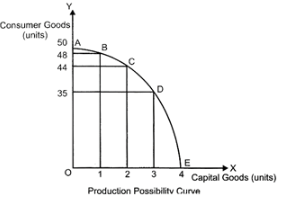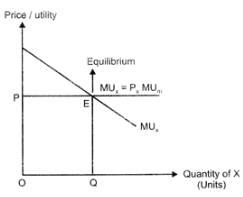Class 12 Economics Solved Paper (2014 Outside Delhi Set-I) | Additional Study Material for Commerce PDF Download
Ques 1: The government has started promoting foreign capital. What is its economic value in the context of Production Possibilities Frontier?
Ans: Promotion of foreign capital by the government will lead to an increment in resources as fresh investment into the country. It will increase the production in the country and will lead to a rightward shift in Production Possibility Frontier (PPF).
Ques 2: Define indifference curve.
Ans: A curve that shows different combinations of two commodities that yield the same level of satisfaction to a consumer is called an indifference curve.
Ques 3: Define marginal product.
Ans: Marginal product refers to the change in the total output brought by employing one additional unit of labour. Algebraically, marginal product = change in total product/ change in labour units
Ques 4: What is market supply of a product?
Ans: The total quantity of a commodity supplied by all the producers at a given price during a given period of time is called the market supply of a product.
Ques 5: What is imperfect oligopoly?
Ans: When the firms produce different products in an oligopoly market, it is called imperfect oligopoly, e.g., automobile industry.
Ques 6: Why is Production Possibilities Curve concave? Explain.
Ans: The Production Possibility Curve is concave because marginal rate of transformation, which is the slope of the curve, increases continuously as each additional unit of one good is produced by reducing quantity of the other good. It means to produce more and more units of one good, more and more units of other good need to be sacrificed. MRT and opportunity cost increases because no resource is equally efficient in production of all goods. This can be explained with the help of the following diagram.

In the above figure, AE represents the PPC for capital good, and consumer goods. Suppose that the initial production point is B, where 1 unit of capital good and 48 units of consumer goods are produced. To produce one additional unit of capital good, 4 units of consumer good must be sacrificed (point Q Thus, at point C, the opportunity cost of one additional capital good is 4 units of consumer goods. Further moving to point D, to produce one more unit of capital good, 9 units of consumer goods must be sacrificed. That is, the opportunity cost rises to 9 units of consumer goods. Thus, as we move down the PPC from point C to point D, the opportunity cost and MRT increase. This confirms the concave shape of the PPC.
Ques 7: Explain how technological progress is a determinant of supply of a good by a firm.
Or
Explain how input prices are a determinant of supply of a good by a firm.
Ans: The level of technology directly affects the supply of a good. That is, while other things remain the same, there exists a positive relationship between the state of technology and the quantity produced. With the appreciation in the level of production techniques, per unit cost of production goes down. This encourages the producers to produce higher quantities of goods, thereby increasing the supply of the goods.
On the contrary, a depreciation in the production technology raises the per unit cost of production, thereby decreasing the supply of good.
Or
Input prices are related to the supply of a good. If the prices of inputs increases then the cost of production also increases, while other things remain the same. Due to the rise in the cost of productions, it becomes relatively less profitable for a producer to produce the good. Consequently, lesser quantity is supplied at the given price. On the other hand, if the input prices falls, the cost of production also falls, thereby enabling the producer to supply more quantities of output at the given price. Thus, the change in the input prices positively affects the supply of a product.
Ques 8: Why is Average Revenue always equal to price?
Ans: Average Revenue (AR) is defined as the revenue earned per unit of output sold. AR is the same as the price (P) of the output (Q). Algebraically, it can be expressed as follow:
AR=TR/Q, where TR is total revenue,
TR=P × Q
Thus, AR is always equal to the price of the output.
Ques 9: Why is the number of firms small in oligopoly? Explain.
Ans: Oligopoly refers to the form of market where very few big firms (giants) own major control over the whole market by producing significant portion of the market demand. The number of firms is small in oligopoly, because there exists a cut-throat competition among the firms which makes it very difficult for any new firm to enter the industry. Moreover, as the existing firms are the only giants in the market, new entry into the market is associated with high costs, which further narrows the scope for a new entrant.
Ques 10: A consumer consumes only two goods X and Y and is in equilibrium. Show that when the price of good X rises, the consumer buys less of good X. Use utility analysis.
Or
Given the price of a good, how will a consumer decide as to how much quantity of that good to buy? Use utility analysis.
Ans: In case of two commodities, the consumer's equilibrium is attained at that point, where; the utility derived from each additional unit of the rupee spent on each of the goods is equal. That is, Marginal Utility of a Rupee spent on the good X (i.e.,  ) is equal to the Marginal Utility of a Rupee spent on the good Y (i.e.,
) is equal to the Marginal Utility of a Rupee spent on the good Y (i.e., ), which in turn is equal to the Marginal Utility of Money (MUM)? That is
), which in turn is equal to the Marginal Utility of Money (MUM)? That is

However, when the price of commodity X rises, the ratio of marginal utility to price of  becomes lower than that of Y, that is
becomes lower than that of Y, that is  .
.
In such a case, the consumer rearranges his consumption combination such that the equality is again restored. He would decrease his consumption of commodity X. With the decrease in the consumption of commodity X, marginal utility of X rises. As a result, the ratio of marginal utility to price of X rises. The consumer would continue decreasing the consumption of commodity X till the equality between the ratio of marginal utility to price in case of X and Y is again reached.
Or
In order to decide, how much of a good to buy at a given price, a consumer compares Marginal Utility (MU) of the good with its price (P). The consumer will be at equilibrium, when the Marginal Utility of the good will be equal to the price of the good. i.e., MUx=Px. If MUx>Px. that is, when price is lesser than the Marginal Utility, then the consumer will buy more of that good. On the other hand, if MUx<Px′ that is when price is more than the Marginal Utility, then the consumer will buy less of good. This is reflected in the following diagram.

In the figure, the quantity of commodity x is represented on the x-axis, while, the price and the utility are represented on the y-axis. OP is the price of the commodity.MUx curve is downward sloping representing diminishing Marginal Utility of x. The consumer attains consumers equilibrium at point E, where, the Marginal Utility becomes equal to the price of the commodity.
|
4 videos|168 docs
|





















